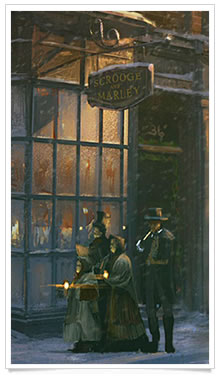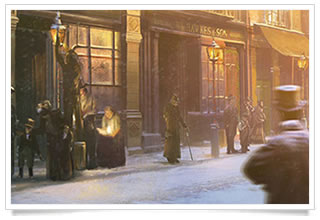by Rev. Lonie Eatherton

It’s just not Christmas without A Christmas Carol. Every year the crotchety old Ebenezer Scrooge, whose best response to Christmas is “Bah! Humbug!” goes through the most frightening and revealing past, present, and future scenes of his otherwise pitiful existence and, having lived through it all, has a dramatic change of heart and is wonderfully transformed into “as good a friend, as good a master, and as good a man as the good old City knew.” And when all is said and done, little Tiny Tim has yet one more thing to say to top it all off: “God bless us, every one!”
But what is the “spirit of Christmas” anyway? Charles Dickens himself might argue that the essential “spirit” is the “Christian” spirit. A Christmas Carol is, after all, a demonstration in story form of what kind of spirit should be alive and active in each and every Christian, especially at Christmastime.
However, what is most important for every Christian is the following question: Does the Gospel even make an appearance in A Christmas Carol?
Charles Dickens did not claim to be a preacher of the Gospel. He did claim to be a Christian. But his writing quite often reflected what he thought about how Christianity was practiced in his day. It was not always good. The poor were oppressed. Poor children were uneducated and doomed to a life of want. The rich often did little to help those in need. And it seemed to Dickens that there was so much to be done. Simply put, Charles Dickens was a preacher of social reform.
Dickens’s portrayal of Christianity is very common but, nevertheless, very false. It judges people as either good or bad with no apparent regard for whether they trust in Jesus Christ for forgiveness or not. Check out these examples.
Tiny Tim
Tiny Tim is the very picture of innocence and purity, the teacher of the Christian way. Bob Cratchit tells his wife, “He told me, coming home, that he hoped the people saw him in the church, because he was a cripple, and it might be pleasant to them to remember, upon Christmas Day, who made lame beggars walk and blind men see.”
Is Jesus only a good person who helps poor people in their physical needs? Where is the Savior from sin?
Dickens never allows Tim to speak that Gospel message. All we are allowed to see is his so-called goodness. That, we are led to believe, is all there is to Christianity.
Scrooge
“Oh, but he was a tight-fisted hand at the grindstone, Scrooge! A squeezing, wrenching, grasping, scraping, clutching, covetous old sinner.” Do we see our own sinfulness in Scrooge? Or do we see him as evil and ourselves as good in comparison?
When Scrooge finally falls to his knees at his own tombstone, he is a broken man. He is, we can assume, genuinely remorseful, or at least terrified at the thought of dying as the miserable scoundrel that he has become. Does he turn to God and ask forgiveness? No, he turns to the “Spirit” and pleads for a chance to change his life and make amends. “I will honor Christmas in my heart, and try to keep it all the year.”
Scrooge awakens on Christmas morning a changed man. Before his ordeal, he found joy in nothing. Now he is “as light as a feather . . . as happy as an angel . . . as merry as a schoolboy . . . as giddy as a drunken man,” and he takes delight in everything from his bed curtains to the lusty ringing of the church bells around him.
But did you remember that one of his first activities of the day was, as Dickens records it, “He went to church”? Oh, how good it would beto think that Scrooge heard the Gospel there, and took it to heart, and rejoiced above all things, in Jesus Christ, his Savior. But Dickens moves us quickly on to watch Scrooge walking the streets of the city, patting the children on their heads, talking to beggars, and watching the common people. These are the things that “give him so much happiness.”

Now What?
What then is truly Christian in A Christmas Carol? In the end, Scrooge is reformed but not saved. And it is not even the Christmas Gospel that gives him a change of heart. God the Holy Spirit would have surely given him joy in Jesus, the Savior. All the “spirits” can do for him is arouse his hidden human emotions and scare him half to death! This is not Gospel.
In short, although Dickens’s classic Christmas tale hints at the Gospel throughout, it completely leaves outthe true Christmas message: that Jesus Christ was born into this world to save sinners. A Christmas Carol not only lacks the Gospel, it denies the Gospel. It substitutes a different gospel, that is, our love for one another. Our sympathy and kindness to others is made to do the work that only God’s love and forgiveness for sinners can do.
How, then, does a Lutheran respond? No, we don’t need to toss Dickens’ well-loved story in the trash. We can enjoy it as the classic literature it is. But we can be aware of what’s lacking also. As parents, when we read A Christmas Carol to our children, or watch our favorite movie version together, we can discuss the story and remind them what Jesus, “the one who made lame beggars walk and blind men see,” did for every sinner by dying on the cross.
Jesus’ birth is still the greatest Christmas story ever. Jesus was born to be our Savior! This is the story that changes our lives and blesses us. And so we say with Tiny Tim, “God bless us, every one!”
—
About the Author: Rev. Lonie Eatherton is pastor of Our Savior Lutheran Church, Fenton, Mo.
December 2010





